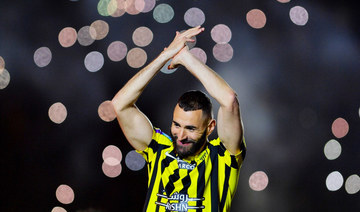Asian football has never seen anything like this.
Over the past decade or two, we have seen a number of the world’s best players make the move to Asia: Rivaldo signed for Bunyodkor in Uzbekistan, Alessandro del Piero for Sydney FC, Xavi for Al Sadd and Andres Iniesta for Vissel Kobe, to name just a few.
There was also the explosion in China in the mid-to-late 2010s that saw the likes of Oscar, Hulk and Carlos Tevez make the move east.
But the scale of what we are witnessing in Saudi Arabia is unlike anything we have seen before.
Quite aside from the impact within Saudi Arabia, the landmark signing of Karim Benzema along with other names such as N’Golo Kante and Sergio Busquets — and let’s not forget a certain Cristiano Ronaldo in all of this — has the potential to completely reshape the face of Asian football.
HIGHLIGHT
With three of the big four clubs — Al-Ittihad, Al-Hilal and Al- Nassr — all due to participate in the AFC Champions League this coming season, the benefit for Asia’s premier club competition could be immediate.
There are significant differences between what happened in the Chinese Super League and what is taking place in Saudi Pro League now. While the project in China had state backing, it was largely financed by private real estate developers and fell apart as soon as the ruling Chinese Communist Party party tried to cool the spending largesse. The project in Saudi Arabia, however, is directly linked to the country’s Vision 2030 agenda.
Just this week, Crown Prince Mohammed bin Salman outlined a new vision for sport in the country, and in particular football, with leading clubs to be privatized. The big four are all being taken over by the Public Investment Fund, and the annual revenue of the SPL will be increasing from $120 million to a staggering $480 million.
The sheer scale and ambition are unlike anything ever seen in Asian football, with the ultimate aim of having the SPL as one of the 10 best leagues worldwide.
What that means for Asian football could be seismic.
“The investment in Saudi domestic football is one of the pivotal moments in the (Asian Football Confederation),” James Kitching, former FIFA director and leading sports executive, told Arab News.
“It will drive viewership in Saudi football, and by extension, AFC competitions, as big names ply their trade in Riyadh, Jeddah, Dammam, and other cities. It will increase competitiveness in men’s AFC club competitions, as other clubs strive to keep up and compete with the Saudi clubs, which many already struggle to do.
“Similarly, a new generation of Saudi youth will reap the benefits and will likely usher in a new era of success in AFC men’s youth competitions and consistent participation in youth World Cups.
“The knock-on effect will mean that other nations will need to invest heavily in their technical development and club professionalization to remain competitive, which in turn increases the levels of men’s football in Asia across the board.”
With three of the big four clubs — Al-Ittihad, Al-Hilal and Al-Nassr — all due to participate in the AFC Champions League this coming season, the benefit for Asia’s premier club competition could be immediate.
That the AFC and its media partner Football Marketing Asia are about to go to market for the next commercial cycle for the revamped AFC club competitions is quite serendipitous. It should be an easy sell.
“Saudi Arabian club football is currently in the top three leagues in Asia; the outcome of this investment will balloon it into the stratosphere,” Kitching, also a former senior executive at the AFC, continued.
“Unlike the Chinese bubble, which burst, this is a long-term commitment into one of the biggest cultural institutions in the country — football. The level of investment is a message that Saudi Arabia is serious, and a force to be reckoned with.”
Yasser Al-Misehal, the president of the Kingdom’s football federation, who also sits on both the AFC and FIFA executive committees, is cognizant of the role his country has to play in the development of football across the continent.
“We know the role the league plays in our footballing footprint across Asia,” he told Arab News.
“We have strong partnerships, growing fan bases and of course player recruitment across the AFC. We see Asia as a key component for our future opportunities and ambitions, including football, commercial and investment.
“Football is our country’s favorite sporting passion, and we are working hard to inspire even more to enjoy the beautiful game. This includes investments at all levels, on pitch and off, to provide access for all and even greater opportunity.
“Whether it’s player signings, club ownership or grassroots investments, these recent announcements reflect our country’s ambition to put sport at the heart of everyday life in Saudi Arabia.”
The scale of the investment has raised eyebrows around the world, but for Kitching, increased investment in Asian club football, rather than Europe, is long overdue and could herald a new era for Asian football.
“Saudi Arabia is leading the way, investing heavily in their domestic game, while the rest of the world, and particularly Asian money, is seeking to buy football clubs in Manchester, Milan, London, Rome, and anywhere else that permits private ownership,” the Adelaide-based Kitching said.
“A pillar of AFC policy should be to actively encourage and harness the Asian money being spent outside of Asia on football and seek to have that invested within Asian football — whether domestically, or in Asian club competitions, or both.
“There’s a giant pot of gold that leaves Asia on an annual basis and props up a chunk of European football — leveraging that investment to pay the best players, invest in the best development, and generate the most media rights.
“That money should be spent in Asia.”

























